

Makanalua is a ten-square-mile (16 sq km) peninsula and is part of the North
Shore of Molokai. There are three separate districts on the peninsula:
Kalaupapa, Kalawao and Makanalua. The peninsula is bordered on three sides
by the Pacific, and on the fourth, by vertical cliffs. Early inhabitants of
Molokai made their way in and out mostly by sea, as fishing around the
peninsula was bountiful.

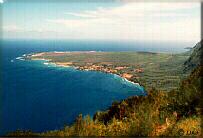 Today, the trail descending the 1,600-foot-high (488m)
cliffs to Kalaupapa is traveled by mules, who transport visitors to and
from Kalaupapa. Some of the workers at the settlement also commute on foot
daily on this trail. Visitors as well may hike the switchback in and out of
Kalaupapa. The peninsula's terrain is flat: Translated, Kalaupapa means "level land resembling a flat leaf."
Today, the trail descending the 1,600-foot-high (488m)
cliffs to Kalaupapa is traveled by mules, who transport visitors to and
from Kalaupapa. Some of the workers at the settlement also commute on foot
daily on this trail. Visitors as well may hike the switchback in and out of
Kalaupapa. The peninsula's terrain is flat: Translated, Kalaupapa means "level land resembling a flat leaf."

Strong northeast trade winds and a lack
of sufficient rainfall make for harsh living conditions. The nearby cliffs
receive more than 25 feet (7.6m) of rain annually, but it disappears through the porous ground. At the near edge is the settlement of Kalaupapa, the only town on the peninsula. At the far edge is the district of Kalawao.

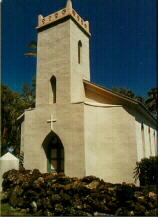 Saint Philomena Church in Kalawao was begun as a small chapel by
Brother Bertrand in 1872. It was here that Father Damien spent his first
nights on Molokai, sleeping on the ground under a hala tree next to the
chapel. The chapel stands today behind the church.
Saint Philomena Church in Kalawao was begun as a small chapel by
Brother Bertrand in 1872. It was here that Father Damien spent his first
nights on Molokai, sleeping on the ground under a hala tree next to the
chapel. The chapel stands today behind the church.

Father Damien added on to St. Philomena twice, more than doubling its size. To accommodate the needs of his congregation, Damien positioned the church so that the gusty trade winds passed through the many windows.

The interior of St.
Philomena was refinished and painted by his parishioners. Because of their
fondness for bright colors, they selected a rainbow of colors to complete
the task.

In 1995, following the beatification ceremonies in Belgium, a
relic of Father Damien was returned to Kalawao and was reinterred next to
the church. Today, St. Philomena stands in homage to Damien the Blessed,
the priest from Belgium.

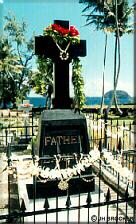
This black, concrete cross marks Father Damien's grave site at
Kalawao. In 1936, his remains were exhumed and returned to Belgium at the
request of their government.

When the relic was returned to Molokai in 1995, a small vault was built in the walls of Damien's original grave. Wrapped in white and black kapa cloth, the relic was placed in a milo wood box and sealed within the vault.

It was Damien's wish to be buried among his
people at Kalawao. Finally, his wishes were respected.

Today, this part of the peninsula is uninhabited, but it is meticulously maintained.
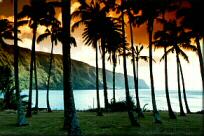

From the Makanalua Peninsula, the view anywhere is breathtaking.

This looks west, past the switchback trail leading down the cliffs to
Kalaupapa and to Ilio Point, the northwest corner of the island.

The bay is the most protected spot on the peninsula. Here, once a year, a barge brings supplies to the residents for the one grocery store, the only gas station, and a bar called Elaine's.

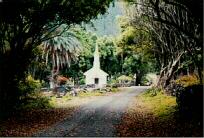
On a tour of the peninsula, you will travel down a road like this
one, called Damien's Road. Carefully tended homes, churches and other
buildings recall the days of decades ago.

Wild pigs, accustomed to being hand fed by residents, are very tame. Curious critters, they often will approach a vehicle, expecting a handout.
|